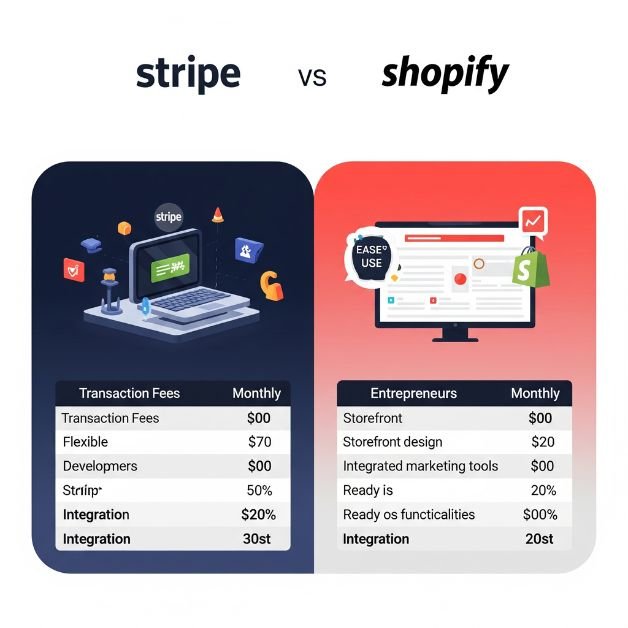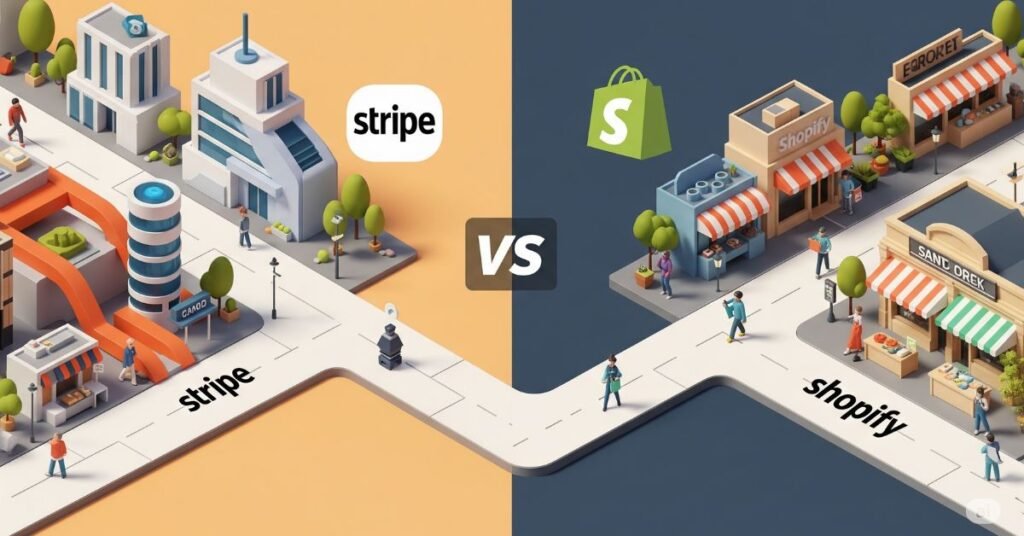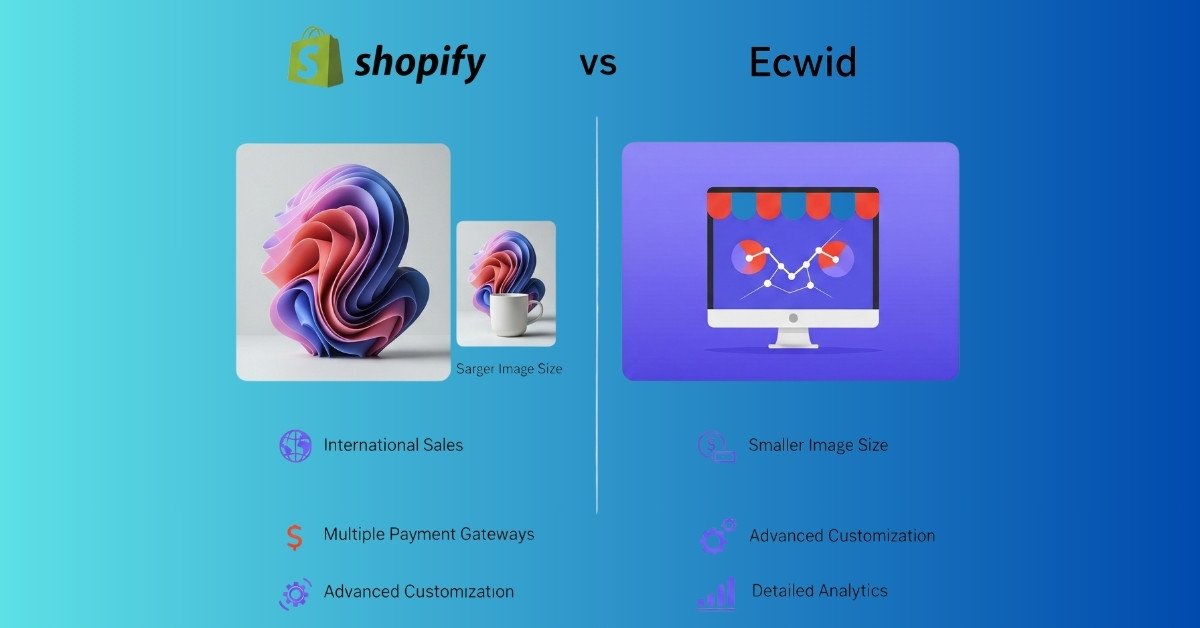Starting an online store feels like a wild ride, doesn’t it? Picking between Stripe vs Shopify can shape your business’s success, from easy payments to happy customers. I’ve been there—launching my first shop, torn between Stripe’s payment processing and Shopify’s e-commerce platform. This guide compares Stripe vs Shopify for e-commerce, breaking down costs, features, and ease to help you choose. Ready to find your perfect match? Let’s jump in!
Understanding Stripe and Shopify: What’s the Difference?
You might ask, “What is Stripe, and how is it different from Shopify?” Stripe offers flexible Stripe payment processing. It handles payments online and in person. It works in over 135 currencies. This makes it good for developers who want to control payments closely.
Shopify is a complete Shopify e-commerce platform. It lets you build and run an online store. This includes making your shop look great and managing your items. Its built-in payment system, Shopify Payments powered by Stripe, makes taking payments easy.
I once used Stripe for a custom website. I liked having full control over payments. But when I needed to open a clothing store fast, Shopify saved me time. Everything just fit together. Shopify Payments uses Stripe’s core technology. Still, it works best within Shopify’s own system.
Deep Dive: A Feature-by-Feature Comparison
Now, let’s really dig into what makes each platform tick. When you’re picking a tool for your business, knowing the specific features helps a lot. We’ll look at how Stripe and Shopify stack up in terms of their main job, how easy they are to use, how much you can change them, their pricing, and if they work well for international sales. This will help us figure out who each one is best for.
Here’s a quick look at the core differences:
| Feature | Stripe | Shopify |
| Primary Function | Payment Processing | All-in-one E-commerce Platform |
| Ease of Use | More technical, developer-focused | Beginner-friendly, intuitive interface |
| Customization | Highly customizable via API | Good customization within platform limits |
| Pricing Model | Pay-as-you-go transaction fees | Monthly subscription + transaction fees |
| International Reach | Extensive global payment and currency support | Good, but more limited than Stripe |
| Best For | Custom websites, developers, complex payment models | Beginners, all-in-one solution seekers, dropshippers |
Stripe vs Shopify Payments: Key Features Compared
Let’s dive into the nitty-gritty of what each platform offers. This part is about finding which tool has the features you need. We will compare how they handle payments, what you can change, and what extra tools they give you.
Payment Methods
Stripe is great for many ways to pay. It takes credit and debit cards. It also handles digital wallets like Apple Pay and Google Pay. You can use bank transfers, too. Plus, it supports “buy now, pay later” choices like Klarna. Stripe really gives you a lot of options.
Shopify Payments offers similar ways to pay. It takes major cards and digital wallets. It also includes Shop Pay, which is Shopify’s own fast checkout. But keep in mind, these options work only for Shopify stores.
Customization
Stripe lets you change things a lot. Its tools, called APIs, are perfect for developers. If you have unique business needs, you can make payments work exactly how you want. This is a big plus for custom websites.
Shopify Payments has less freedom for changes. But it works very well with Shopify’s whole system. This makes it simple to set up payments in your store. It just fits right in.
Additional Features
Shopify gives you many helpful tools. It helps you track your items. It also has marketing tools and website designs. It’s a full package for running an online store. I found Shopify’s POS (Point of Sale) handy for selling in person. It keeps my online and in-store sales linked.
Stripe also has useful features. It can handle payments for subscriptions. It also helps with sending bills. And it has Stripe Radar, which fights fraud with smart tech. I remember Stripe Radar caught a strange payment on my site once. It saved me from a costly problem.
Here’s a table to show the features side-by-side:
| Feature | Stripe | Shopify Payments |
| Payment Methods | Credit/debit cards, digital wallets, ACH, BNPL options | Credit/debit cards, digital wallets, Shop Pay |
| Customization | High (via APIs) | Limited (seamless with Shopify ecosystem) |
| Additional Tools | Subscription billing, invoicing, fraud prevention (Radar) | Inventory, marketing, website templates, POS |

Pricing and Transaction Fees: Stripe vs Shopify Payments
Ever stress about how fees eat into your online store’s profits? Comparing Stripe vs Shopify pricing feels like checking the price tags on two different tools—one’s a la carte, the other’s a bundle. I’ve crunched the numbers for my own shops, so let’s break down the Shopify vs Stripe transaction fees to help you pick what’s affordable.
Stripe Pricing: Stripe uses a pay-as-you-go model with no monthly fees. You pay 2.9% + $0.30 per online sale and 2.7% + $0.05 for in-person. Extra fees, like 1.5% for international payments, can add up. Stripe has no subscription costs but charges per transaction.
Shopify Payments Pricing: Shopify Payments skips extra transaction fees if you use their platform, but you need a Shopify plan ($24–$2000+/month). Fees range from 2.4%–2.9% + $0.30 per online sale, based on your plan. I saved $100/month by switching to Shopify Payments for my clothing store, avoiding third-party fees. Shopify Payments ties fees to your subscription plan.
Third-Party Fees: Using Stripe on Shopify adds 0.5%–2% per transaction. This hit my budget hard when I tried it for my custom app. Knowing these costs helps you plan smarter. Stripe on Shopify adds extra fees; Shopify Payments avoids them.
Pricing Table: Stripe vs Shopify Payments (US – Online Transactions)
| Platform | Monthly Fee | Transaction Fee |
| Stripe | $0 | 2.9% + 30¢ |
| Shopify Payments (Basic) | Starts at $29/mo | 2.9% + 30¢ |
| Shopify Payments (Shopify) | Starts at $79/mo | 2.6% + 30¢ |
| Shopify Payments (Advanced) | Starts at $299/mo | 2.4% + 30¢ |
Ease of Use and Integration
Setting up a payment system can feel like a big hurdle. But how hard is it, really? Let’s look at how simple it is to get started with Stripe vs Shopify integration. We’ll also see how they work with other tools.
Stripe
Stripe needs a bit more technical know-how. If you want to customize how it works, you might need someone with coding skills. Think of it like building a custom car. You can make it exactly what you want, but it takes effort. However, Stripe does offer ready-made options for platforms like WooCommerce. This makes it simpler for some users.
Shopify Payments
Shopify Payments makes setup a breeze. It’s built right into Shopify, so you don’t need any special tech skills. It’s like buying a ready-to-drive car. You just turn it on and go. For most Shopify users, this is a huge plus.
Integration with Shopify
Can you use Stripe with Shopify? Yes, you can. But it’s not as simple as using Shopify Payments. You have to set it up yourself. Also, Shopify charges extra fees if you use Stripe as a third-party processor. These fees can be 0.5% to 2% of your sales. This really adds up. I tried using Stripe’s API for a custom part of my site once. It worked, but the learning curve was steep. Shopify Payments was so much easier to set up for my main store.
Steps for Stripe Integration
If you decide to go with Stripe on Shopify, here are the general steps:
- Create your Stripe account. Make sure it is active and verified.
- Log into your Shopify admin. Head to the settings.
- Go to the “Payments” section. Here, you can manage your payment providers.
- Choose “Add payment method.” Then, search for Stripe.
- Connect your Stripe account. You will log into Stripe to link it to Shopify.
- Activate the integration. Double-check that everything is set up correctly.
Choosing between Stripe and Shopify’s ease of use often comes down to your comfort with technology. Are you a hands-on builder or do you prefer an all-in-one solution?
Stripe vs Shopify Payments: Which is Better for Your Business?
Picking between Stripe vs Shopify for your online store often depends on your business and what you need. It is like choosing tools for a job. Both work, but one might fit your task better.
Shopify Payments Is Best For:
- Shopify store owners wanting simple tools. If you use Shopify already, Shopify Payments works smoothly. You will not pay extra fees from Shopify. This saves you money. It makes everything easy.
- Small businesses wanting easy tools. If you are new to online selling, Shopify is great. It handles many tasks. This includes inventory and marketing. Shopify Payments makes managing your shop simple. For my dropshipping store, it was the clear choice. I wanted to focus on selling.
Stripe Is Best For:
- Businesses needing custom setups. If your website is unique, Stripe offers flexibility. It is good for developers. You can change how payments work. This helps if you have special needs.
- Businesses needing global reach. Stripe works in more countries. It supports many currencies. If you sell worldwide, Stripe for international business can handle diverse payments.
- Non-Shopify platforms. If you do not use Shopify, Stripe is a good pick. It works with many systems. Think of platforms like WooCommerce. Stripe is a standalone payment system.
- Developers or businesses with complex payment needs. Stripe has strong tools for subscriptions. It helps with custom billing. If you have these needs, Stripe works well. For my custom app, Stripe’s flexibility was key. It helped with recurring payments.
Think about your business growth when you choose. Consider where your customers live. Also, think about your industry. Some businesses have more rules for payments. Both Stripe and Shopify have good security. Stripe Radar helps stop fraud. Shopify Payments has fraud analysis built-in.
The best choice depends on your business goals. It also depends on how much control you want. Do you like a simple, all-in-one system? Or do you want to change every detail?
Security and Fraud Prevention
Keeping your online store safe from bad actors is a big deal. Nobody wants to lose money to fraud. Both Stripe and Shopify Payments work hard to protect your sales. They use smart tools to spot risky payments.1
Stripe uses something called Stripe Radar for fraud detection.2 Think of it like a smart guard for your money. It uses machine learning, which means it learns from tons of data across many businesses. This helps it find and block suspicious payments in real-time. I remember a time Stripe Radar flagged a strange order on my site. It looked fishy, and it saved me from a costly problem.
Shopify Payments also has built-in fraud analysis. It gives you alerts if an order looks risky. It watches things like the billing address and if the card has been used before. This helps you decide if you should ship an order or look into it more. You get real-time alerts.
When a customer disputes a charge, it is called a chargeback. Both platforms charge a fee for this. It is usually around $15 per chargeback. Shopify might process these faster. If you win the dispute, Shopify usually refunds this fee.3 Stripe does not always refund the fee, even if you win.
Pros and Cons Summary Table
Choosing the right tool for your online store can feel like a puzzle. Both Shopify and Stripe bring their own strengths and weaknesses to the table. It helps to see them side-by-side to make a good choice.
Here is a quick look at what makes each platform stand out, and where they might fall short:
| Platform | Pros | Cons |
| Shopify | Easy to use, all-in-one e-commerce platform, good website templates, integrated payment solution. | Monthly subscription fees, less flexible for custom payment needs, tied to the Shopify ecosystem. |
| Stripe | Powerful tools for developers (APIs), wide global payment support, good for subscriptions and custom billing, no monthly fees. | More technical to set up, does not include a storefront, can have extra fees when used with other platforms like Shopify. |
Export to Sheets
For my own shops, I have found that Shopify is great if you want simplicity and everything in one place. It handles so many tasks, from building the site to managing orders. However, if you need a lot of control over payments or plan to sell on many different platforms, Stripe gives you that flexibility. It is all about what fits your business best.
Global Reach and Currency Support
Thinking about selling your products to customers all over the world? Then you need to think about global reach and currency support. It is like picking a passport for your payment system. Some passports let you travel everywhere, and some are more limited.
Stripe is pretty much a global passport for your payments. It works in over 46 countries. It can handle payments in more than 135 different currencies. This means if you have customers in Europe, Asia, or anywhere else, Stripe can likely process their payments. For my business, I found Stripe for international business made selling to customers in different countries much easier. I did not have to worry about complex currency conversions.
Shopify Payments is great for simplicity, but it has fewer stamps in its passport. It is available in about 23 countries. It supports fewer currencies than Stripe. This might be fine if you sell mostly in your home country or a few key markets. But if you dream of a truly global online store, Stripe might be a better fit for your needs. Selling to Europe was easier for me with Stripe’s currency conversion.

Customer Support and User Reviews
Getting help when you need it can be tricky. You want quick, useful answers when something goes wrong with your online store. Let’s see how Stripe and Shopify Payments help their users. We will also check what people say about them.
Stripe has support that focuses on developers. This means if you build custom sites, their guides are very detailed. It is like a big instruction book for people who code. But if you just run a business, getting quick, personal help might be hard. Their help often needs you to know some tech words.
Shopify Payments gives 24/7 support. You can talk to them by chat, email, or phone. This is great if a problem comes up in the middle of the night. I remember my store had a small issue with a discount. Shopify’s live chat fixed it in minutes. It was a huge help.
People online often talk about how easy Shopify is to use. They like that it is an all-in-one tool. For Stripe, users often point out its power and flexibility. This is especially true for unique business needs. Some users, though, say Stripe’s support feels less personal.
Both platforms have good and bad points for support. If you like reading guides or have a coder on your team, Stripe’s help might work. But if you want fast, direct help, Shopify’s support is often better.
Final Thoughts: Making the Right Choice for Your Business
Picking Stripe vs Shopify feels like choosing the right key for your shop’s door. I’ve used both, so let’s wrap up what matters to help you decide. E-commerce payment solutions like these shape your store’s success.
Stripe offers flexibility and global reach. It’s perfect for custom sites or big world markets. I used Stripe for my app’s subscriptions, and it handled payments smoothly. Stripe fits custom or non-Shopify stores best.
Shopify Payments keeps things simple with tight integration. It saves cash by skipping extra fees. My clothing store thrived with Shopify’s easy tools. Shopify Payments is great for Shopify users wanting ease.
Check your needs: scale, platform, or custom tweaks. Try both if you can! For my Shopify store, I picked Shopify Payments, but Stripe powered my app. Choose what fits your goals for online store payment gateways.
FAQs About Stripe vs Shopify Payments
Got questions about Stripe vs Shopify Payments? You are not alone! Many business owners wonder about the best payment processor for their online store. Let’s tackle some common questions. I will share some real-world examples to make things clear.
What’s the main difference between Stripe and Shopify Payments?
Stripe is a standalone payment processor, like a general bank for online payments.1 You can use it with many different websites and platforms. Think of it as a tool you can plug into almost anywhere. Shopify Payments, on the other hand, is Shopify’s own payment system. It runs on Stripe’s technology but is built right into your Shopify store.2 It is like having a special bank inside your Shopify shop. This means Shopify Payments works seamlessly with your Shopify store.3
Can I use Stripe with Shopify?
Yes, you can use Stripe with Shopify. However, Shopify usually charges extra fees if you use a payment processor other than Shopify Payments.4 These fees can be 0.5% to 2% of your sales. I found this out the hard way when I tried to use Stripe directly with one of my Shopify stores for a special feature. The extra fees added up quickly. It is simpler and often cheaper to stick with Shopify Payments if you are on Shopify.
Which is better for subscriptions?
Stripe offers robust subscription billing features, making it a strong choice for subscription businesses.5 It has tools built specifically for handling recurring payments and managing customer subscriptions.6 Shopify can do subscriptions, but it often needs extra apps like Recharge from the Shopify App Store. For my subscription box service, I switched to Stripe to handle my billing. It gave me more control and saved me money on app fees.
Which is cheaper for small businesses?
Shopify Payments avoids third-party fees, which can make it cheaper for small businesses using a Shopify store.7 If you use Shopify Payments, you do not pay the extra transaction fees that Shopify charges for using other payment processors.8 Stripe has no monthly subscription costs for its basic service, but it charges per transaction.9 So, if you have a Shopify store, Shopify Payments can be more cost-effective. But if you do not use Shopify, Stripe’s lack of monthly fees can be a big plus.
Read more: Ecwid Review




